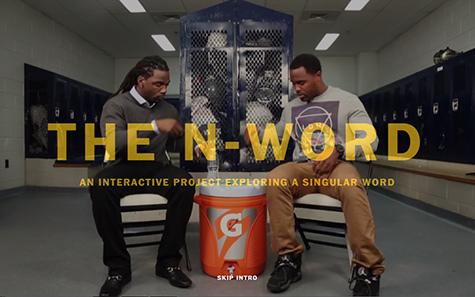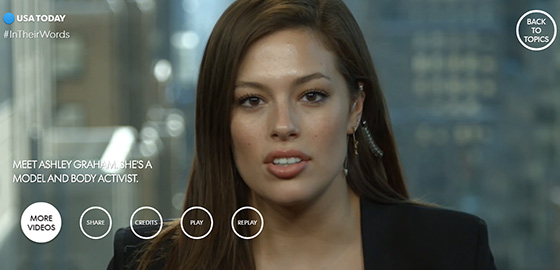
With more news outlets experimenting with new methods to personalize news, three recent approaches show significant advancements. The Wall Street Journal, Washington Post and USA Today have created noteworthy interactive experiences exploring race, gender issues and health care.
“For the majority of my career in journalism, we’ve been treating the collection of news very much like we always have: a reporter takes in information and interprets it and gives it out to users,” said Tory Hargro, a design manager at USA Today. “I think in order to make that stuff real, you cannot keep it at a national conversation level; you have to show people how it impacts them personally. And anytime we can show a person how a story impacts them personally, that equals high-engagement.”
And it may be just the beginning.
Susan McGregor, assistant director of Columbia University’s Tow Center for Digital Journalism, said the kind of personalized storytelling in these projects can help make news more engaging.
“It can let people connect more deeply and relate more immediately to the subject of the story,” McGregor said.
While The Journal, Post and USA Today are not alone in experimenting with personalization, AJR takes a look at some of their efforts.
Wall Street Journal: Personalizing Healthcare
When the Affordable Health Care Act kicked off, the Wall Street Journal offered readers a “personalized tour of ‘Obamacare’” with “Prescribed.”
A first-person video journey, shot using a helmet cam, leads users through a potential day in their own lives, complete with a ride to work and a trip to the gym. Throughout the video, interactive elements appear, offering viewers the chance to learn more about how the law may specifically apply to them.
For example, a bike crash scene demonstrates how someone may be affected by a trip to the E.R.
Jarrard Cole, senior video journalist, said editors and reporters who worked on the project identified “Obamacare”–the Affordable Care Act–as a big, difficult-to-understand story that warranted a more creative approach.
The lead reporter on the project, Janet Adamy also pointed out that health care is very personal and people are most interested in how it pertains to them specifically, Cole said. That idea gave birth to the first-person concept.
“It forced us to make the topic concrete; it forced us to make it interesting.” Cole said. “If we couldn’t figure out a way to explain it so that one character could see it, we knew we weren’t doing our job of really making the story impactful and making it clear.”
The team worked to take the thousands of pages of content in the law and deliver the information that viewers may be most interested in, Cole said, like mental health concerns or how it would impact a relationship with a doctor. Those topic areas became the basis for the interactive elements.
“We kind of wanted to trick people into learning about other parts of the law too,” Cole said. “So you might just be interested in what affects you… but we wanted to give people the ability to go deeper with the topic when they wanted to.”
In fact, “Prescribed” racked up high view counts, especially compared to other pieces dealing with Obamacare, Cole said. And the team tracked user behaviors within the video as well, like click-through rates for different interactive elements.
“We saw really good engagement. Early on, we saw that folks were actually engaging with the video for longer than the main video runtime, so they were clicking on other things and watching other elements,” Cole said. “The video is about four minutes and we were seeing an average view time exceeded four minutes. So pretty great viewer retention, which is what we were aiming for.”
USA Today: Personalizing Race and Gender Issues
USA Today’s Hargro said transforming and advancing personalization of news is one of his personal missions in journalism. This year, Hargro helped develop two projects that offer a deeper, personalized look at some difficult social issues.
#InTheirWords, released in February, explored the stories of modern civil rights leaders as they discussed issues and impacts of race today. As their faces fill the screen, the subjects discuss navigating black stereotypes and battling discrimination in modern America.
Hargro explained the creative process behind the project in a recent interview with AJR. The key goals, he said, were connecting users directly to the subjects of “powerful stories” and allowing them to delve deeper into the topic areas most interesting to them.
In March, another #InTheirWords project was released in the same format, this time shedding light on women’s issues. The videos consider the major issues facing women in today’s society, including pay equity, perceptions of beauty and sexism.
Both projects saw high engagement, especially on social media, using the designated hashtag. Readers and fellow journalists took to Twitter to discuss the impact of the interactives:
Liked mix of voices and "face-to-face" style of @USATODAY's #intheirwords project. Post-clip UI kept me watching. http://t.co/ffchkTC1lr
— Patrick Cooper (@btrpkc) February 13, 2015
Really well done project by @USATODAY for Blk History Month #InTheirWords http://t.co/kyqnDSufPD
— Pamela Kirkland (@PamelaKirkland) February 12, 2015
This is so cool MT @LizSzabo: @USATODAY explores issues for modern women #intheirwords. Add your voice http://t.co/2b3IXXvFyJ
— Jen Zettel (@jenzettel) March 11, 2015
Hargro said large, tough social issues like race and gender lend themselves to these kinds of personalized interactive stories.
“[They] are similar to political conversations,” Hargro said. “Not just in that they can be very divisive, but in that people come to the conversation with their own set of assumptions and judgments.”
The Washington Post: Personalizing Controversial Speech

The Washington Post invited readers to choose how they wanted to explore information about a racially charged word.
The Washington Post also dealt with complex race issues in a personalized interactive video project published in November 2014. “The n-word” project discussed the controversial role and of just one word in society.
In a similar format to #InTheirWords, users are able to select topic areas regarding the “The n-word” that they would like to explore: “the n-word is more harmful than any other epithet” or “a ban on the n-word is a pointless rule,” for example. A customized video then appears on the screen, tailored to users’ selected interests.
In February 2014, the NFL was deciding whether or not to penalize players for using the n-word on the field and The Washington Post decided to take a harder look at the underlying issue of the n-word itself, said Pamela Kirkland, a video producer at PostTV.
“It kind of sparked the broader question of: What is this word’s role or place in society currently? When is it being used? Where is it being used?…it became kind of a journalistic exploration of this word in our culture at the present moment,” Kirkland said. “We started thinking ‘how can we get people into this project and into this content that we have and make it a more personal experience?’”
Ultimately, the project aimed to offer viewers diverse perspectives on the word, some that would hopefully challenge any preconceived notions and demonstrate some of the nuance within the issue, she said.
Viewers responded pretty positively to the project, Kirkland said. She said she thinks it helped start some important conversations and bring new perspectives to light.
“You can kind of choose the amount of depth that you want, you can interact with the project as much or as little as you want to,” Kirkland said, “and I think the users really appreciated the flexibility that was there, as well as it being personalized and speaking to their own experiences. It was reaffirming experiences that they’ve had or even challenging them on certain things that they felt were important.”
The Society for News Design awarded The Post a gold medal in its “use of multimedia” category for the “The n-word.” Judges praised the project’s approach to the issue and its ability to engage audiences and stimulate conversation.
What’s Next in News Personalization?
Lily Ciric Hoffmann, multimedia lecturer at Philip Merrill College of Journalism at the University of Maryland, said personalization can be empowering to users and help immerse them in the story.
“You can spend as little or as much time as you want to and you can always come back to it for more. It makes you a participant and not just a consumer,” Hoffman said. “I would definitely like to see more stories done this way.”
Still, Hoffman said, journalists have to be careful with how they use personalized elements and that they don’t overpower the story.
“I still believe that less is more and that it’s the story that matters the most,” Hoffman said. “Too many options can be distracting if not done properly and can completely ruin the experience.”
The Tow Center’s McGregor said personalization may not be right for every story, but she would like to see it used moving forward to help people better understand difficult subject matters, like economic and finance stories.
“I think one area that is very challenging, and I would love to see this taken on, is really dealing with financial markets,” McGregor said. “There’s really a phenomenal opportunity and deep challenge to take that information and make that relatable to folks.”
Kirkland, Cole and Hargro agreed these projects represent an early, innovative step in news personalization and future projects are sure to build on their success. Hargro said he thinks journalists are just scratching the surface of personalization’s potential.
“It’s my personal mission to fix the problem of having people not very willing to engage in really important, civil conversations,” Hargro said. “Instead of beating them across the head and saying they should pay attention, I think it’s our job–it’s my job–to present that information to them in a way that they can see the impact very clearly. I think that’s the mission of journalism and it’s a challenge that I really look forward to and hope we can solve.”








